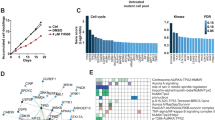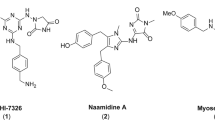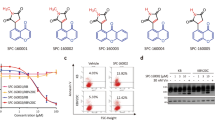Abstract
Mitosis-specific agents have, to date, not been clinically successful. By contrast, microtubule-targeting agents (MTAs) have a long record of success, usually attributed to the induction of mitotic arrest. Indeed, it was this success that led to the search for mitosis-specific inhibitors. We believe the clinical disappointment of mitosis-specific inhibitors stands as evidence that MTAs have been successful not only by interfering with mitosis but, more importantly, by disrupting essential interphase cellular mechanisms. In this Perspective we will review literature that supports a paradigm shift in how we think about one of our most widely used classes of chemotherapeutics—MTAs. We believe that the steady presence and constant physiological role of microtubules are responsible for the overall success of MTAs. While mitosis-specific inhibitors are effective on only a small fraction of the tumor mass (dividing cells), MTAs target tubulin, a protein that has crucial roles in both mitotic and non-mitotic cells.
This is a preview of subscription content, access via your institution
Access options
Subscribe to this journal
Receive 12 print issues and online access
$209.00 per year
only $17.42 per issue
Buy this article
- Purchase on Springer Link
- Instant access to full article PDF
Prices may be subject to local taxes which are calculated during checkout




Similar content being viewed by others
Change history
04 March 2011
In the version of this article initially published online, the legend for Figure 3 should have contained the sentence 'Permission for parts c and d obtained from Elsevier © Mabjeesh, N. J. et al. Cancer Cell 3, 363–375 (2003)'. This has now been corrected for the print, HTML and PDF versions of the article.
References
Jordan, M. A. & Kamath, K. How do microtubule-targeted drugs work? An overview. Curr. Cancer Drug Targets 7, 730–742 (2007).
Brinkley, B. R. Microtubule organizing centers. Annu. Rev. Cell Biol. 1, 145–172 (1985).
Terada, S. & Hirokawa, N. Moving on to the cargo problem of microtubule-dependent motors in neurons. Curr. Opin. Neurobiol. 10, 566–573 (2000).
Marshall, W. F. Basal bodies platforms for building cilia. Curr. Top. Dev. Biol. 85, 1–22 (2008).
Bergen, L. G. & Borisy, G. G. Head-to-tail polymerization of microtubules in vitro. Electron microscope analysis of seeded assembly. J. Cell Biol. 84, 141–150 (1980).
Bergen, L. G., Kuriyama, R. & Borisy, G. G. Polarity of microtubules nucleated by centrosomes and chromosomes of Chinese hamster ovary cells in vitro. J. Cell Biol. 84, 151–159 (1980).
Hirokawa, N., Noda, Y., Tanaka, Y. & Niwa, S. Kinesin superfamily motor proteins and intracellular transport. Nat. Rev. Mol. Cell. Biol. 10, 682–696 (2009).
Kardon, J. R. & Vale, R. D. Regulators of the cytoplasmic dynein motor. Nat. Rev. Mol. Cell. Biol. 10, 854–865 (2009).
Ito, D. & Matsumoto, T. Molecular mechanisms and function of the spindle checkpoint, a guardian of the chromosome stability. Adv. Exp. Med. Biol. 676, 15–26 (2010).
Schmit, T. L. & Ahmad, N. Regulation of mitosis via mitotic kinases: new opportunities for cancer management. Mol. Cancer Ther. 6, 1920–1931 (2007).
Colombo, R. & Moll, J. Target validation and biomarker identification in oncology: the example of aurora kinases. Mol. Diagn. Ther. 12, 71–76 (2008).
Chopra, P., Sethi, G., Dastidar, S. G. & Ray, A. Polo-like kinase inhibitors: an emerging opportunity for cancer therapeutics. Expert Opin. Investig. Drugs 19, 27–43 (2010).
Taylor, S. & Peters, J. M. Polo and Aurora kinases: lessons derived from chemical biology. Curr. Opin. Cell Biol. 20, 77–84 (2008).
Nakai, R. et al. K858, a novel inhibitor of mitotic kinesin Eg5 and antitumor agent, induces cell death in cancer cells. Cancer Res. 69, 3901–3909 (2009).
Harrison, M. R., Holen, K. D. & Liu, G. Beyond taxanes: a review of novel agents that target mitotic tubulin and microtubules, kinases, and kinesins. Clin. Adv. Hematol. Oncol. 7, 54–64 (2009).
Jackson, J. R., Patrick, D. R., Dar, M. M. & Huang, P. S. Targeted anti-mitotic therapies: can we improve on tubulin agents? Nat. Rev. Cancer 7, 107–117 (2007).
Dutertre, S., Descamps, S. & Prigent, C. On the role of aurora-A in centrosome function. Oncogene 21, 6175–6183 (2002).
Sasai, K. et al. Aurora-C kinase is a novel chromosomal passenger protein that can complement Aurora-B kinase function in mitotic cells. Cell Motil. Cytoskeleton 59, 249–263 (2004).
van de Weerdt, B. C. & Medema, R. H. Polo-like kinases: a team in control of the division. Cell Cycle 5, 853–864 (2006).
Kishi, K., van Vugt, M. A., Okamoto, K., Hayashi, Y. & Yaffe, M. B. Functional dynamics of Polo-like kinase 1 at the centrosome. Mol. Cell. Biol. 29, 3134–3150 (2009).
Huszar, D., Theoclitou, M. E., Skolnik, J. & Herbst, R. Kinesin motor proteins as targets for cancer therapy. Cancer Metastasis Rev. 28, 197–208 (2009).
Sarli, V. & Giannis, A. Targeting the kinesin spindle protein: basic principles and clinical implications. Clin. Cancer Res. 14, 7583–7587 (2008).
Zhang, Y. & Xu, W. Progress on kinesin spindle protein inhibitors as anti-cancer agents. Anticancer Agents Med. Chem. 8, 698–704 (2008).
Milas, L. et al. Kinetics of mitotic arrest and apoptosis in murine mammary and ovarian tumors treated with taxol. Cancer Chemother. Pharmacol. 35, 297–303 (1995).
Horton, J. K., Houghton, P. J. & Houghton, J. A. Relationships between tumor responsiveness, vincristine pharmacokinetics and arrest of mitosis in human tumor xenografts. Biochem. Pharmacol. 37, 3995–4000 (1988).
NCI Developmental Therapeutics Program Discovery Services[online], (2010).
Bekier, M. E., Fischbach, R., Lee, J. & Taylor, W. R. Length of mitotic arrest induced by microtubule-stabilizing drugs determines cell death after mitotic exit. Mol. Cancer Ther. 8, 1646–1654 (2009).
Corbett, T. et al. in Anticancer Drug Development Guide: Preclinical Screening, Clinical Trials, and Approval (eds Teicher, B. A. & Andrews, P. A) 99–125 (Humana Press, New Jersey, 2004). [Series Ed. Teicher, B. A. Cancer Drug Discovery and Development].
Tubiana, M. & Malaise, E. in Scientific Foundations of Oncology (eds Symington, T. & Carter, R. L.) 126–136 (William Heinemann Medical Books, London, 1976).
Livingston, R. B., Ambus, U., George, S. L., Freireich, E. J. & Hart, J. S. In vitro determination of thymidine-3H labeling index in human solid tumors. Cancer Res. 34, 1376–1380 (1974).
Baserga, R. The relationship of the cell cycle to tumor growth and control of cell division: a review. Cancer Res. 25, 581–595 (1965).
Smith, J. A. & Martin, L. Do cells cycle? Proc. Natl Acad. Sci. USA 70, 1263–1267 (1973).
Rixe, O. & Fojo, T. Is cell death a critical end point for anticancer therapies or is cytostasis sufficient? Clin. Cancer Res. 13, 7280–7287 (2007).
Denduluri, N. et al. Phase II trial of ixabepilone, an epothilone B analog, in patients with metastatic breast cancer previously untreated with taxanes. J. Clin. Oncol. 25, 3421–3427 (2007).
Dancey, J. T., Deubelbeiss, K. A., Harker, L. A. & Finch, C. A. Neutrophil kinetics in man. J. Clin. Invest. 58, 705–715 (1976).
Steeghs, N. et al. Phase I pharmacokinetic and pharmacodynamic study of the aurora kinase inhibitor danusertib in patients with advanced or metastatic solid tumors. J. Clin. Oncol. 27, 5094–5101 (2009).
Mross, K. et al. Phase I dose escalation and pharmacokinetic study of BI 2536, a novel Polo-like kinase 1 inhibitor, in patients with advanced solid tumors. J. Clin. Oncol. 2 6, 5511–5517 (2008).
Crosio, C. et al. Mitotic phosphorylation of histone H3: spatio-temporal regulation by mammalian Aurora kinases. Mol. Cell. Biol. 22, 874–885 (2002).
Steegmaier, M. et al. BI 2536, a potent and selective inhibitor of polo-like kinase 1, inhibits tumor growth in vivo. Curr. Biol. 17, 316–322 (2007).
Giannakakou, P. et al. p53 is associated with cellular microtubules and is transported to the nucleus by dynein. Nat. Cell. Biol. 2, 709–717 (2000).
Hsu, L. C. & White, R. L. BRCA1 is associated with the centrosome during mitosis. Proc. Natl Acad. Sci. USA 95, 12983–12988 (1998).
Lotti, L. V. et al. Subcellular localization of the BRCA1 gene product in mitotic cells. Genes Chromosomes Cancer 35, 193–203 (2002).
Roth, D. M., Moseley, G. W., Glover, D., Pouton, C. W. & Jans, D. A. A microtubule-facilitated nuclear import pathway for cancer regulatory proteins. Traffic 8, 673–686 (2007).
Zhu, M. L. et al. Tubulin-targeting chemotherapy impairs androgen receptor activity in prostate cancer. Cancer Res. 70, 7992–8002 (2010).
Gundersen, G. G. & Cook, T. A. Microtubules and signal transduction. Curr. Opin. Cell Biol. 11, 81–94 (1999).
Ganansia-Leymarie, V., Bischoff, P., Bergerat, J. P. & Holl, V. Signal transduction pathways of taxanes-induced apoptosis. Curr. Med. Chem. Anticancer Agents 3, 291–306 (2003).
Herbst, R. S. & Khuri, F. R. Mode of action of docetaxel—a basis for combination with novel anticancer agents. Cancer Treat. Rev. 29, 407–415 (2003).
Etienne-Manneville, S. From signaling pathways to microtubule dynamics: the key players. Curr. Opin. Cell Biol. 22, 104–111 (2010).
Jang, H. J. et al. Taxol induces oxidative neuronal cell death by enhancing the activity of NADPH oxidase in mouse cortical cultures. Neurosci. Lett. 443, 17–22 (2008).
Pasquier, E. et al. Antiangiogenic activity of paclitaxel is associated with its cytostatic effect, mediated by the initiation but not completion of a mitochondrial apoptotic signaling pathway. Mol. Cancer Ther. 3, 1301–1310 (2004).
Tran, T. A. et al. Non-anti-mitotic concentrations of taxol reduce breast cancer cell invasiveness. Biochem. Biophys. Res. Commun. 379, 304–308 (2009).
Kanthou, C. & Tozer, G. M. Tumour targeting by microtubule-depolymerizing vascular disrupting agents. Expert Opin. Ther. Targets 11, 1443–1457 (2007).
Pasquier, E., André, N. & Braguer, D. Targeting microtubules to inhibit angiogenesis and disrupt tumour vasculature: implications for cancer treatment. Curr. Cancer Drug Targets 7, 566–581 (2007).
Dark, G. G. et al. Combretastatin A-4, an agent that displays potent and selective toxicity toward tumor vasculature. Cancer Res. 57, 1829–1834 (1997).
Forsyth, P. A. et al. Prospective study of paclitaxel-induced peripheral neuropathy with quantitative sensory testing. J. Neurooncol. 35, 47–53 (1997).
Postma, T. J., Vermorken, J. B., Liefting, A. J., Pinedo, H. M. & Heimans, J. J. Paclitaxel-induced neuropathy. Ann. Oncol. 6, 489–494 (1995).
DeAngelis, L. M., Gnecco, C., Taylor, L. & Warrell, R. P. Jr. Evolution of neuropathy and myopathy during intensive vincristine/corticosteroid chemotherapy for non-Hodgkin's lymphoma. Cancer 67, 2241–2246 (1991).
Mielke, S., Sparreboom, A. & Mross, K. Peripheral neuropathy: a persisting challenge in paclitaxel-based regimes. Eur. J. Cancer 42, 24–30 (2006).
Sahenk, Z., Barohn, R., New, P. & Mendell, J. R. Taxol neuropathy. Electrodiagnostic and sural nerve biopsy findings. Arch. Neurol. 51, 726–729 (1994).
Argyriou, A. A., Koltzenburg, M., Polychronopoulos, P., Papapetropoulos, S. & Kalofonos, H. P. Peripheral nerve damage associated with administration of taxanes in patients with cancer. Crit. Rev. Oncol. Hematol. 66, 218–228 (2008).
Giles, F. J. et al. MK-0457, a novel kinase inhibitor, is active in patients with chronic myeloid leukemia or acute lymphocytic leukemia with the T315I BCR-ABL mutation. Blood 109, 500–502 (2007).
Smith, D. C. et al. A phase I study of XL228, a multitargeted protein kinase inhibitor, in patients (pts) with solid tumors or multiple myeloma [abstract]. J. Clin. Oncol. 28 (15 Suppl.) a3105 (2010).
Andersson, K., Mahr, R., Björkroth, B. & Daneholt, B. Rapid reformation of the thick chromosome fiber upon completion of RNA synthesis at the Balbiani ring genes in Chironomus tentans. Chromosoma 87, 33–48 (1982).
Carvalho, C. et al. Doxorubicin: the good, the bad and the ugly effect. Curr. Med. Chem. 16, 3267–3285 (2009).
Pommier, Y. Camptothecins and topoisomerase I: a foot in the door. Targeting the genome beyond topoisomerase I with camptothecins and novel anticancer drugs: importance of DNA replication, repair and cell cycle checkpoints. Curr. Med. Chem. Anticancer Agents 4, 429–434 (2004).
Noordhuis, P., Holwerda, U., Van Laar, J. A., Van der Wilt, C. L. & Peters, G. J. A non-radioactive sensitive assay to measure 5-fluorouracil incorporation into DNA of solid tumors. Nucleosides Nucleotides Nucleic Acids 23, 1481–1484 (2004).
DiMasi, J. A., Hansen, R. W. & Grabowski, H. G. The price of innovation: new estimates of drug development costs. J. Health Econ. 22, 151–185 (2003).
Adams, C. P. & Brantner, V. V. Estimating the cost of new drug development: is it really 802 million dollars? Health Aff. (Millwood) 25, 420–428 (2006).
Acknowledgements
The authors would like to thank S. X.Yung for immunohistochemical staining of breast cancer samples. This work was supported in part by the Intramural Research Program of the Eunice Kennedy Shriver National Institute of Child Health and Human Development.
Author information
Authors and Affiliations
Contributions
All authors contributed to researching the data for the article. E. Komlodi-Pasztor, D. Sackett and T. Fojo made a substantial contribution to discussion of the content, writing the article and preparing it for submission.
Corresponding author
Ethics declarations
Competing interests
The authors declare no competing financial interests.
Supplementary information
Supplementary Table 1
Targets of mitotic-kinase inhibitors (DOC 82 kb)
Supplementary Table 2
Lung cancer: tumor doubling times (DOC 66 kb)
Supplementary Table 3
Colon cancer: doubling time of serum CEA (DOC 49 kb)
Supplementary Table 4
Colon cancer: tumor doubling times (DOC 41 kb)
Supplementary Table 5
Hepatocellular carcinoma: tumor doubling times (DOC 65 kb)
Supplementary Table 6
Breast cancer: tumor doubling times (DOC 61 kb)
Supplementary Table 7
Prostate cancer: doubling time of serum PSA (DOC 68 kb)
Supplementary Table 8
Prostate cancer: tumor doubling times (DOC 37 kb)
Supplementary Table 9
Melanoma: tumor doubling times (DOC 45 kb)
Supplementary Table 10
Neutrophil cellularity and kinetics in humans (DOC 39 kb)
Supplementary Table 11
Partial list of proteins that traffic on or associate with microtubules (DOC 80 kb)
Supplementary Table 12
Agents that disrupt mitosis: limited activity to date (DOC 75 kb)
Rights and permissions
About this article
Cite this article
Komlodi-Pasztor, E., Sackett, D., Wilkerson, J. et al. Mitosis is not a key target of microtubule agents in patient tumors. Nat Rev Clin Oncol 8, 244–250 (2011). https://doi.org/10.1038/nrclinonc.2010.228
Published:
Issue Date:
DOI: https://doi.org/10.1038/nrclinonc.2010.228
This article is cited by
-
p53 and p21 dynamics encode single-cell DNA damage levels, fine-tuning proliferation and shaping population heterogeneity
Communications Biology (2023)
-
Exposure to low intensity ultrasound removes paclitaxel cytotoxicity in breast and ovarian cancer cells
BMC Cancer (2021)
-
Nanoscale characterization of drug-induced microtubule filament dysfunction using super-resolution microscopy
BMC Biology (2021)
-
The biology and rationale of targeting nectin-4 in urothelial carcinoma
Nature Reviews Urology (2021)
-
Disruption of the MSL complex inhibits tumour maintenance by exacerbating chromosomal instability
Nature Cell Biology (2021)



